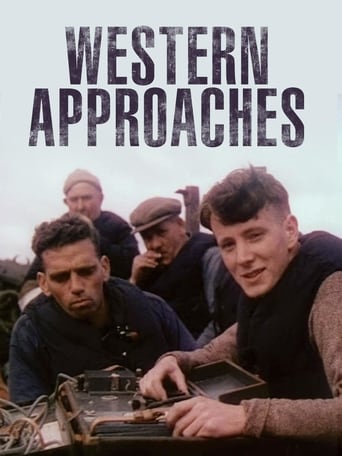
A World War II drama-documentary showing the struggles of Merchant Navy seamen following an attack by a U-Boat. Western Approaches is a vast area of ocean control covering thousands of square miles of the Atlantic. In these waters is set this single incident in the fiercest and longest sea battle in history. The players are not professional actors but serving officers and men of Allied Navies and Merchant Fleets. This film is dedicated to them and their comrades who made the Allied victory possible.
Reviews
Excellent, Without a doubt!!
The acting in this movie is really good.
The biggest problem with this movie is it’s a little better than you think it might be, which somehow makes it worse. As in, it takes itself a bit too seriously, which makes most of the movie feel kind of dull.
The film's masterful storytelling did its job. The message was clear. No need to overdo.
This was yet another classic British wartime 'documentary', one I was wary of in view of its feature-length (80 minutes) – especially, at this juncture, having been somewhat let down by a few of its contemporaneous ilk – but which would prove a surprisingly positive experience. Like the recently-viewed THE SILENT VILLAGE (1943), the documentary epithet (not to mention its title!) is misleading here, since it is actually a narrative film – albeit a re-enactment of a true WWII episode – that just happens to feature non-professional actors. Indeed, it can be said that such wartime efforts were "neo-realist" before the term was even coined or the style had actually taken off in Italy! Still, it is debatable whether the end result would have been this noteworthy had professional performers been employed rather than real naval servicemen – since it tells a standard (albeit undeniably gripping) tale of a rescue at sea and the ensuing scuttling of a U-Boat!Apart from Clifton Parker's evocative score, two novelty aspects are employed here that make the whole show all the more appealing to the casual viewer: the fact that it was shot in Technicolor (by the great Jack Cardiff, no less); the documentary pedigree itself allowed for (or, I should say, excused) the copious use of language that would otherwise not have been permissible for the era – such as "bastards", "bloody", "damn" and "hell"...not to mention sketches of naked women adorning the walls of the radio operators' quarters! For what it is worth, director Jackson would eventually break into commercial film-making but never again approached the reasonable level of excellence achieved in this case!
Gripping wartime re-enactment of perils at sea by the very people who experienced the harrowing events here depicted (with one or two exceptions), this is an engrossing movie with some of the finest color photography of the decade. Jackson's direction of his non-professional cast is so immaculately adept, it's hard to believe that these are real people on the screen, re-living real events, not actors going through their paces in a script carefully honed for the utmost drama and suspense. True, real events have been telescoped, but, if anything, the terrors we see on the screen have been diluted, rather than magnified. In fact, the whole movie is a tribute not only to the men of the Royal Navy, but to the skill of the film-makers.This was writer-director Pat Jackson's first feature film, yet oddly he was not able to capitalize on his sudden fame. Metro-Goldwyn-Mayer put him under contract, but kept him hanging around doing nothing (and getting paid for it) until handing him a routine "B" assignment starring Ann Sothern and Zachary Scott, Shadow on the Wall, to direct in 1950.Returning to England, Jackson directed White Corridors and one of the Somerset Maugham stories in Encore in 1951. A disappointing Anthony Steel vehicle, intended as an "A" feature but understandably released as a "B", Something Money Can't Buy, followed in 1952. Jackson then remained idle until 1956 when he directed a routine Belinda Lee vehicle, The Feminine Touch, which even made the lovely Belinda seem dull and uninspired. A boring hero (George Baker) didn't help either; while a similarly lack-luster cast (Tony Britton, Sylvia Sims, Jack Watling) and script undermined The Birthday Present (1957). Jackson was fast earning a reputation as a routine hack, but managed to redeem himself with Virgin Island (1959) in which he had the services of a fine group of players headed by Sidney Poitier, John Cassavettes, Virgina Maskell. Although the movie achieved great notices, it failed to recoup its modest negative cost.My guess is that at this point Jackson lost interest – and no wonder! He found work directing two "B" features, Snowball (1960) and Seven Keys (1961). His remaining six films, with the exception of What a Carve Up! which successfully attempted to cash in on the popularity of the Carry On movies – in fact many critics (including me) headlined our reviews, Carry On Carving – were likewise disappointments. In 1964 and 1968, he even directed and wrote quota quickies, Seventy Deadly Pills and On the Run, respectively, for the Children's Film Foundation. So that makes On the Run actually his last movie. King Arthur, the Young Warlord (1975) is a TV cut-down – as was To Chase a Million (1967).P.S. I've omitted Don't Talk to Strange Men (1962) from this line-up. It was banned in 1962 and I've never seen it, although reportedly it is an effective (if very small-scale) thriller.
Very worthwhile reading Pat Jackson's memoir of his beginnings in film, in "Retake Please - Night Mail to Western Approaches" Conversational style easy to follow, and fascinating to learn how he and his crew achieved what they did, sometime through great hardship. He gives a lot of detail as to how effects were achieved, or not as the case may be. Reading his accounts brings home how ground breaking he was in creating his "documentary" style. Much criticism has been levelled at other war documentarians (EG Frank Hurley, II World war, Antarctic, photographer) for falsifying photos in order to achieve the romance of or horror of what they wanted to convey. It is clear in this memoir that Pat Jackson saw himself as having a "rallying the troops" job to do and he had no qualms using the illusions capable in the film technology of the time to get his message across. The most satisfying aspect of this memoir is his warmth and fondness for the people he met along the way, he often quotes from their first meetings in great detail, particularly the non professional casts he employed in Western Approaches. A wonderful read.
The British film industry created a genre in the documentary-type war movie (San Demetrio London, The Cruel Sea, The Colditz Story, etc., etc.) and many of these are now regarded as classics. I am very surprised to see there are no comments on IMDb for 'Western Approaches' because it's a great little film and unique in several ways.Firstly, it was shot in colour by Jack Cardiff, one of the best cinematographers around (think of the use of colour in 'Black Narcissus' and 'The Red Shoes'). The small red sail of the lifeboat set against the unending grey of the sea makes for some wonderful images.Second, the cast were genuine merchant seaman who had fought in the Battle of the Atlantic. Their performances may not be up to professional standards perhaps, but they are heartfelt - thanks to their understanding of the situation torpedoed seamen faced in the war.The plot builds a good deal of suspense into the dilemma of the sailors who want to be rescued, of course, but know they are being used as a decoy for another U-Boat kill.If you get the chance to see this, don't miss it, it's a fine piece of film-making.
Top Streaming Movies













